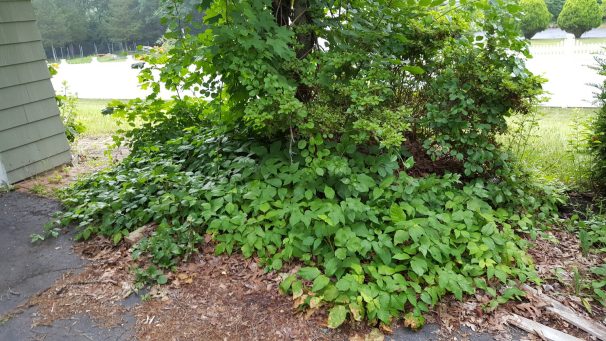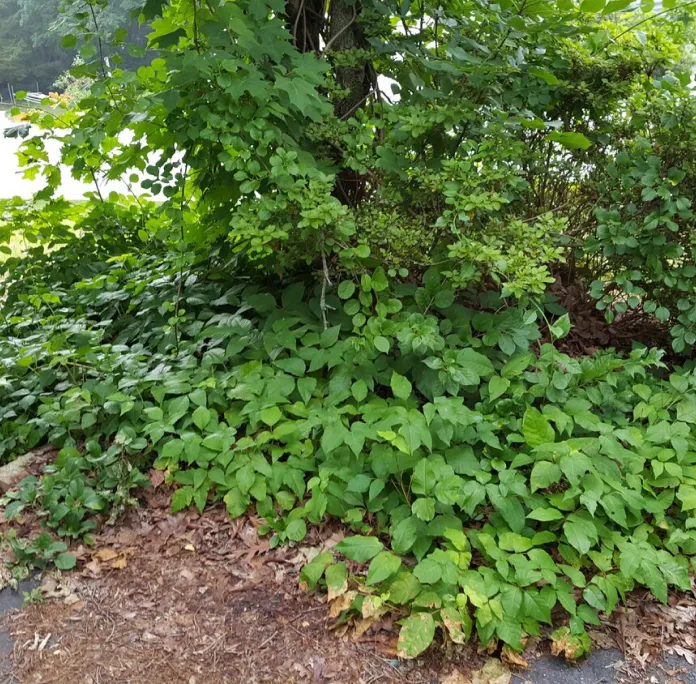Discovering Poison Ivy in Your Garden: What Every Gardener Needs to Know
You’ve spent months nurturing your tomatoes and watching your zucchini flourish. Then one day, while reaching for a ripe pepper, you notice something unwelcome lurking at the edge of your garden bed – a suspicious three-leaved plant that makes your stomach sink. Is that poison ivy?
If you’re a gardener on the East Coast, you’re not alone. Poison ivy has an unfortunate habit of showing up exactly where we don’t want it: right next to our prized vegetables, along garden fences, and sometimes even winding through flower beds. It’s one of the most frustrating problems a homeowner can face because it doesn’t just threaten your plants – it threatens your ability to safely enjoy the garden you’ve worked so hard to create.
Gardens are particularly vulnerable to poison ivy because the disturbed soil, regular watering, and sunlight that help your vegetables thrive also create ideal conditions for poison ivy. Once it takes hold near your garden, every trip out to harvest, weed, or water becomes a potential exposure risk.
Before diving into how to handle this problem, make absolutely sure you’re dealing with poison ivy and not a harmless lookalike. If you’re not completely certain, check out our comprehensive guide on how to identify poison ivy. You’ll want to be 100% sure before starting any removal efforts.

Why Poison Ivy Loves Your Garden Space
Poison ivy is opportunistic, and your garden offers everything it needs. The edges of garden beds, where cultivated soil meets lawn or wild areas, are particularly attractive. You’ve already loosened and enriched the soil, creating the perfect environment for poison ivy seeds to germinate.
According to the University of Connecticut’s Home & Garden Education Center, poison ivy thrives in various conditions but particularly loves edge habitats that gardens naturally create. Birds are frequent culprits – they eat poison ivy berries and deposit seeds through their droppings. Sometimes poison ivy simply creeps over from neighboring properties, sending runners underground that pop up right next to your tomatoes.
Once established, poison ivy actively competes with your garden plants for water, nutrients, and space. Left unchecked, it can quickly transform from a small nuisance into a garden-dominating problem in just a single growing season.
The Hidden Dangers of Garden Poison Ivy
The real problem isn’t just that poison ivy is there – it’s that gardening requires you to be hands-on. You’re kneeling to pull weeds, reaching through foliage to pick vegetables, and working the soil. Any of these activities could bring you into contact with poison ivy, even if you’re trying to avoid it.
Urushiol oil is sticky and persistent. It transfers easily to anything it touches: gardening gloves, tool handles, pants legs, even your dog’s fur. You might carefully avoid the poison ivy itself, only to get a rash later from touching contaminated gloves. This is why it’s important to know how to neutralize poison ivy residue on your gear.
Another hidden danger is the underground root system. Poison ivy’s roots spread laterally underground, sometimes several feet from the visible plant. When you dig to plant seedlings or turn soil, you could expose yourself to urushiol from those underground roots.
Assessing Your Poison Ivy Problem
Before deciding how to tackle your situation, understand exactly what you’re dealing with. Start your evaluation from a safe distance – no touching. Your first question: how much poison ivy are we talking about? A single small plant or multiple plants along the entire perimeter?
Consider the growth habit. Is it ground cover or has it started climbing? Climbing poison ivy is more complex – if it’s climbed your fence or intertwined with your plants, you’re dealing with a trickier situation.
Ask yourself these questions:
- Can I clearly see where the poison ivy ends and my garden begins?
- Are there multiple plants or just one?
- Is it intertwined with plants I want to keep?
- Do I have proper protective equipment?
- Am I highly sensitive to poison ivy?
Your honest answers will guide your next steps.
Safe DIY Methods for Small Poison Ivy Problems
Not all poison ivy problems are good candidates for DIY removal, especially near gardens. But if you have a very small, isolated patch that’s not intertwined with your plants, you might consider tackling it yourself.
Manual Removal Approach
You’ll need full protection: long pants, long-sleeved shirt, waterproof gloves (not cloth—the oil soaks through), boots, and safety glasses. According to the EPA’s guidance on poison ivy, simply cutting the plant at ground level will result in regrowth from roots.
Use a shovel to dig around the plant in a wide circle, going at least six inches deep. Lift out the entire root ball and place everything directly into heavy-duty plastic bags. After removal, every item that contacted the poison ivy needs decontamination or disposal. For detailed guidance, check out how to maintain poison ivy gear.
Chemical Control Options
Herbicides can be effective but using them near vegetable gardens is problematic. Most herbicides that kill poison ivy are non-selective, meaning they’ll also damage your vegetables and herbs. If considering herbicides, extreme caution is needed about timing and application method.
What Can Go Wrong
The most common mistake is incomplete removal. Miss even a small piece of root, and the plant returns, often more vigorously. Partial removal can actually stimulate new growth from remaining roots. Working close to delicate garden plants while removing poison ivy risks damaging your vegetables or leaving urushiol oil on plants you’ll be handling regularly.
When to Call in the Professionals
If poison ivy has established itself in multiple garden areas, professional removal is the smarter choice. The same goes for vines that have climbed structures, wrapped around desirable plants, or spread throughout large areas.
Professionals understand how to work in tight spaces around sensitive plants, completely extract root systems, and ensure no urushiol oil is left behind. They can identify whether poison ivy has spread underground beyond what’s visible and spot young plants you might overlook.
Professional services have access to techniques and treatments impractical for homeowners, including targeted herbicide application with precision equipment.
Protecting Your Garden After Removal
Successfully removing poison ivy is a victory, but monitoring for regrowth should become part of your regular routine. Check removal areas at least weekly during the growing season. Early detection makes all the difference.
Consider dense ground covers that will compete with poison ivy seeds. Mulch applied 2-3 inches thick around garden edges can suppress new growth and makes spotting any emerging poison ivy easier. For comprehensive strategies, our guide on community strategies for poison ivy prevention offers valuable insights.
Prevention: Keep Poison Ivy Away Long-Term
Regular property inspections are your first line of defense. Walk your property’s perimeter monthly during growing season, paying special attention to fence lines and edges where lawn meets wooded areas. Catching poison ivy when it’s a seedling is infinitely easier than dealing with mature plants.
Sometimes poison ivy creeps over from neighbors’ yards. A friendly conversation often resolves the issue. After storms, check thoroughly—severe weather can spread seeds and introduce new plants.
Wide, clear garden pathways that are easy to inspect reduce the chances of poison ivy establishing itself in overlooked corners.
Getting Back to Safe Gardening
Dealing with poison ivy near your garden is absolutely solvable. Whether you’ve removed a small patch yourself or scheduled professional removal, you’ve taken action to protect your garden and family. Remember: proper identification comes first, thorough removal is essential, and ongoing vigilance prevents future problems.
Take Action to Protect Your Garden Today
If you’re dealing with poison ivy near your garden or vegetable beds, you don’t have to handle it alone. Poison Ivy Free specializes in safe, effective poison ivy removal that protects your garden plants while eliminating the threat completely. We understand the unique challenges of working around vegetable gardens and have the expertise to remove poison ivy thoroughly without damaging plants you’ve worked hard to grow.
Serving homeowners throughout Connecticut and along the entire East Coast, we provide comprehensive services tailored to your property’s specific needs.
Don’t let poison ivy keep you out of your garden another day. Call (860) 209-6000 for a free estimate. We’ll evaluate your property, answer your questions, and provide a clear plan to reclaim your garden space safely and effectively.

